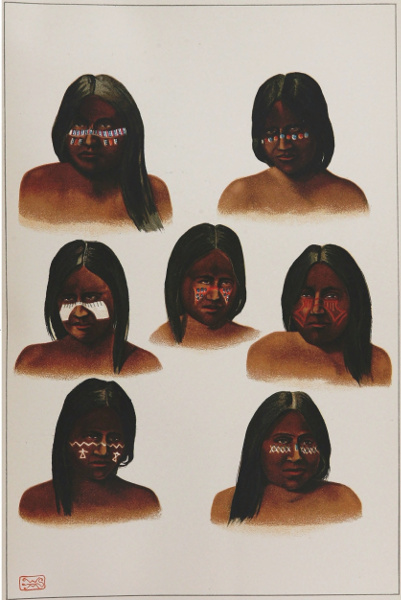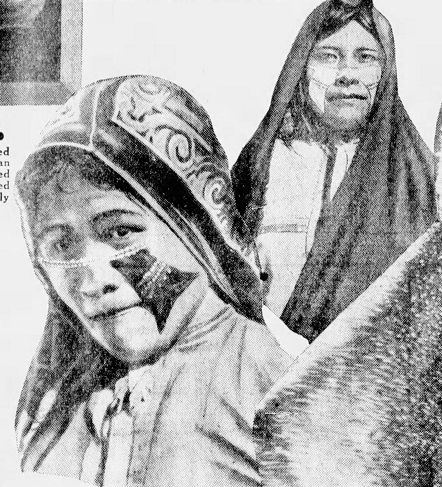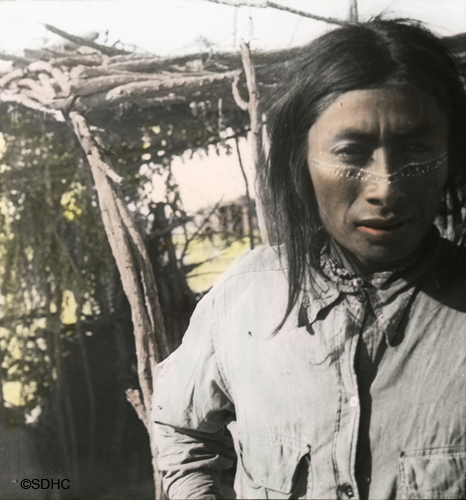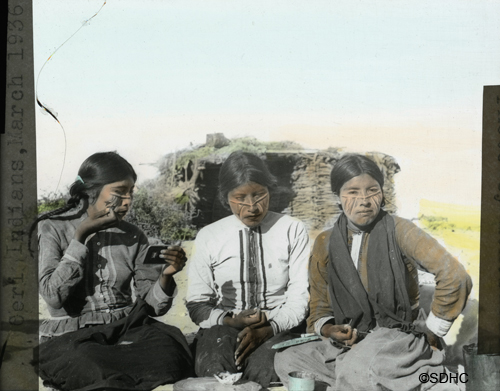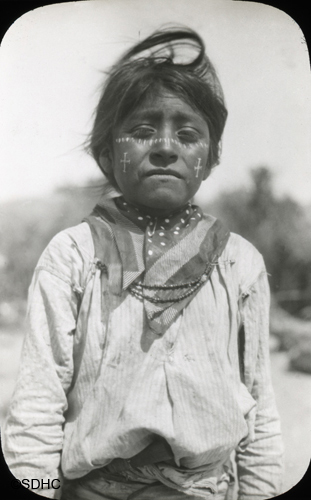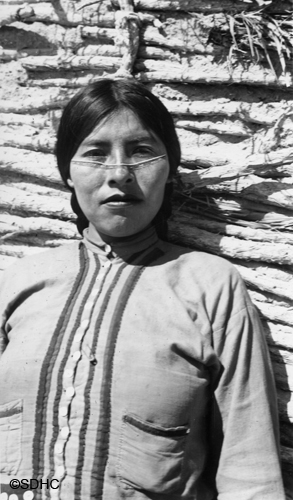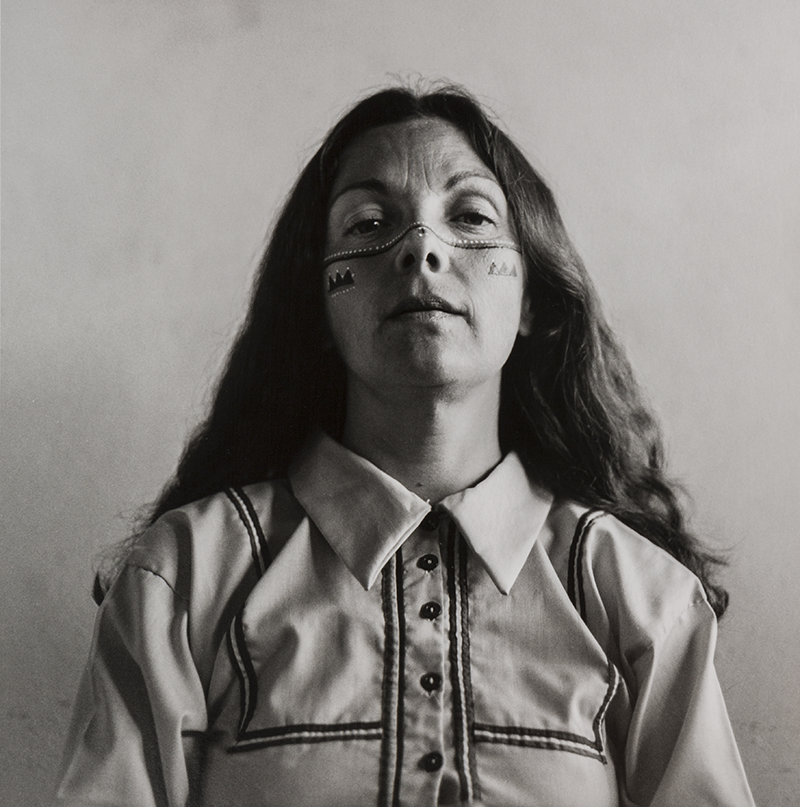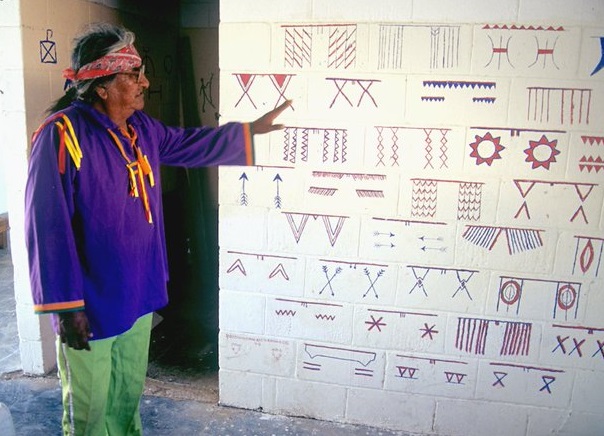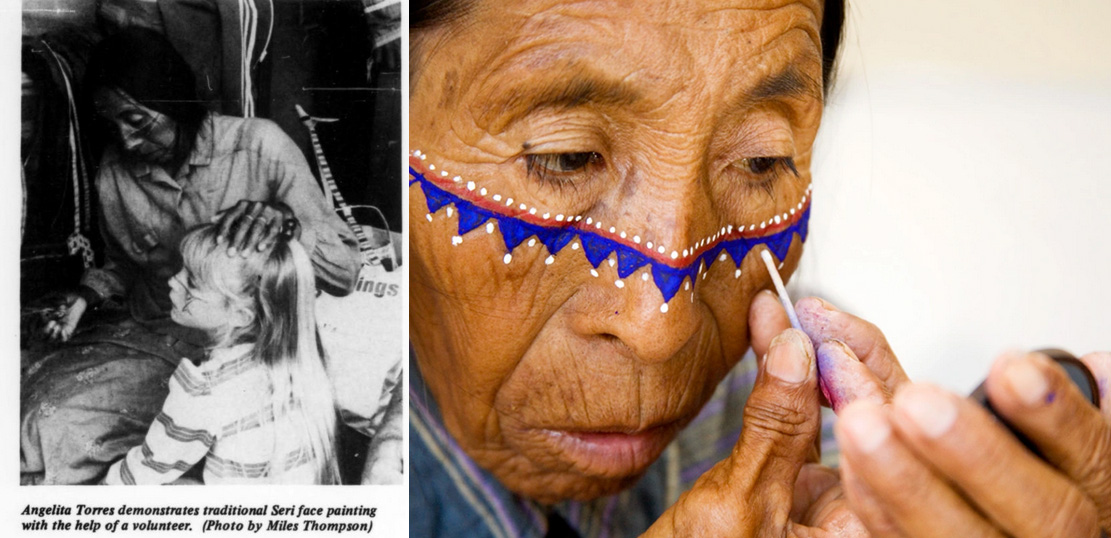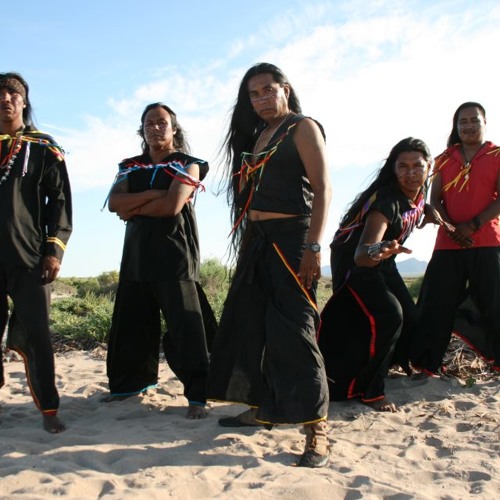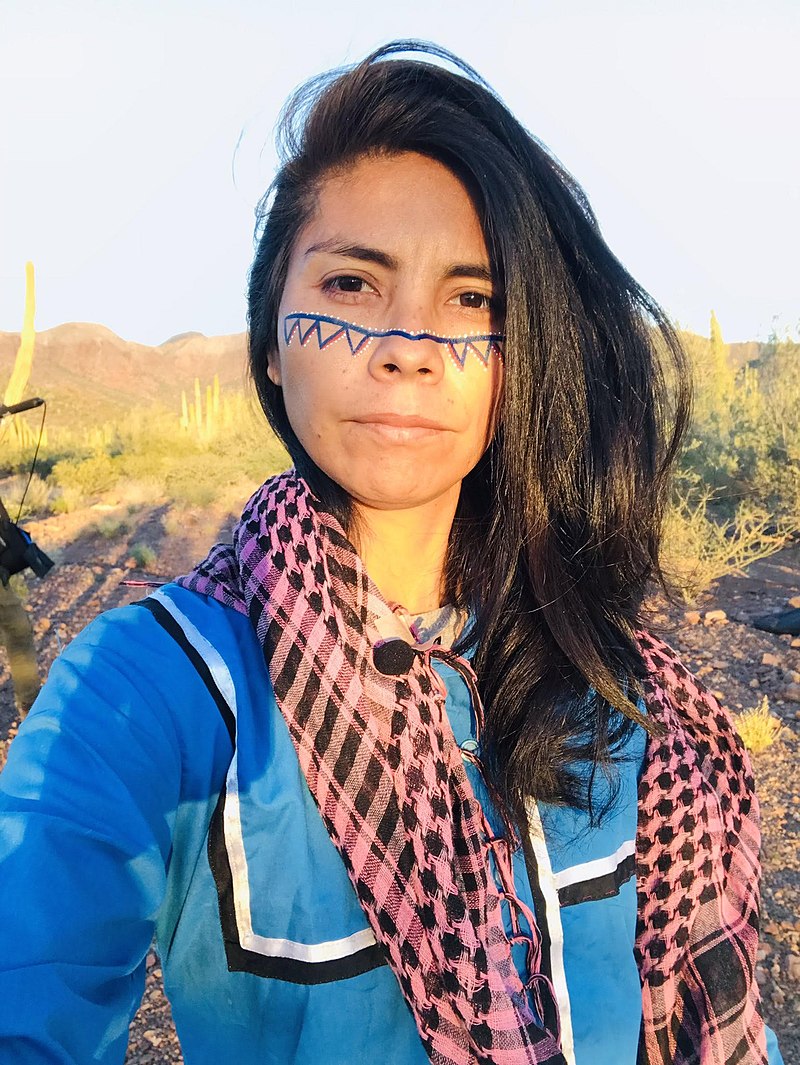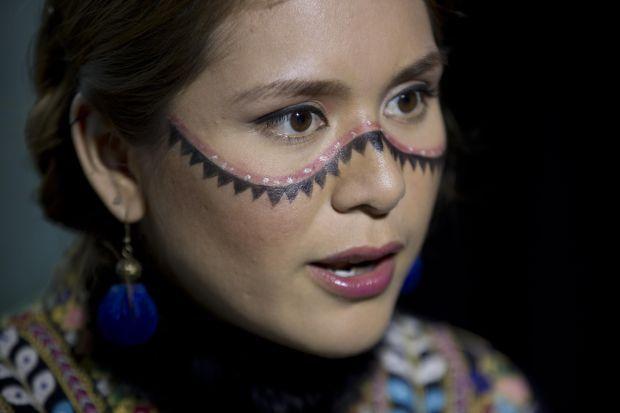Discussing various styles of face paint1 worn by different Indigenous peoples is critical for a better understanding of the history of cosmetics and recognizing that makeup outside of the modern industry exists. For many people across the globe, cosmetics beyond mass produced items have been part of their culture for millennia. The practices of the Seri or Comcáac ("the people") will be briefly surveyed in this post.2
Former nomads, the Seri live in Northwest Mexico, specifically in the Sonoran desert. Men, women and children engaged in face painting, but not equally: it was mostly women who wore it and almost always applied it. One of the earliest accounts by an American of Seri face painting practices was published in 1898. While an incredibly racist retelling – the words "primitive" and "savage" are staples – William J. McGee's history of who wore face paint and why at least provides a starting point for analysis. He states, "On noting the individual distribution of face-painting, it is found to be practically confined to the females, though male infants are sometimes marked with the devices pertaining to their mothers, as adult warriors are said to be on special occasions; and so far as observed all the females, from aged matrons to babes in arms, are painted, though sometimes the designs are too nearly obliterated by wear to be traceable…none of the men or larger boys were painted." McGee hypothesizes that the designs could be loosely categorized as corresponding to one of three clans: the Turtle:
The Pelican:
And the Rattlesnake, seen on the lower left of this illustration:
(images via gutenberg.org)
Further, McGee proposes that the designs take after animal markings either as a warning to others or as simple identification. "[The] designs are sacred insignia of totemic character, serving to denote the clans of which the tribe is composed…On analyzing the directive markings of animals, it is convenient to divide them into two classes, distinguished by special function, usual placement, and general relation to animal economy: the first class serve primarily to guide flight in such manner as to permit ready reassembling of the flock; they are usually posterior, as in rabbit, white-tail deer, antelope, and various birds; and they primarily signify inimical relations to alien organisms, with functional exercise under stress of fear. The second class of markings serve primarily for mutual identification of approaching individuals…the directive markings of the first class are substantially beacons of danger and fear, while those of the second are just as essentially standards of safety and confidence; and they may properly be designated as beacon-markings and standard-markings, respectively…careful analysis would seem fully to justify the casual impression of functional similitude between the Seri face-painting and the directive markings of social animals."
Finally, McGee notes that the most visible markings are displayed by male animals and by that logic, the men instead of women should have their faces painted. He explains, however, that women primarily wear it as they are the "blood-carriers" of the clans. "While the first survey establishes a certain analogy between the primitive face-painting and the standard-markings of animals, an important disparity is noted when the survey is extended to individuals; for among beasts and birds the standards are usually the more conspicuously displayed by the males, while the paint devices of the Seri are confined to the females…the females alone are the blood-carriers of the clans; they alone require ready and certain identification in order that their institutional theory and practice may be maintained; and hence they alone need to become bearers of the sacred blood-standards. The warriors belong to the tribe…but on the females devolves the duty of defining and maintaining the several streams of blood on which the rigidly guarded tribal integrity depends."3 Instead of admitting this theory may be flawed in the sense that he did not consider other, more plausible reasons for women being the primary wearers of face paint, McGee was steadfast in the accepted beliefs of the time, which treated all Native peoples and their practices as uncivilized curiosities.
To a white audience, McGee's arguments about the Seri's use of face paint were persuasive, but more inaccuracies about their cosmetic practices and other customs persisted throughout the 1930s and '40s. A widely published article in 1936 asserted that Seri women used large beauty patches in preparation to be auctioned off to a husband.4
While the face paint patterns appear to be patches in this poorly reproduced photo, there has never been any evidence to suggest the Seri used anything other than paint. (Incidentally, this is the only source that also discusses the selling of brides. My guess is that, as with most reports of Indigenous peoples throughout the 20th century, news outlets embellished or flat-out lied about their cultures to sell papers.) The sensationalized feature Ripley's Believe It Or Not also claimed that the Seri painted their faces green, which is completely false.5
Fortunately, subsequent publications in the mid-20th century challenge McGee's findings and provide a more accurate account of the Seri's face painting traditions. In 1946, Gwyneth Harrington Xavier published her observations on the Seri from five trips she made to their land between 1937 and 1945. "Face painting is the most outstanding adornment of the Seri, and in its highly stylized and beautifully executed patterns it approaches a true art…The basis of the style is a horizontal bar straight across the nose and cheeks, with design elements pendant from the latter. The forehead and chin are never painted." She disputes McGee's insistence that face painting indicated belonging to a certain clan. Instead, Xavier found that the designs were mostly used for artistic creation and beautification among women, with distinctions between married and unmarried women. And while the men indicated they used to wear face paint for war in "the old days," the practice was rare now among them, and was used for adornment than any other purpose.
There was also no distinction between the designs for married and unmarried men. "The women paint frequently (not just for special occasions), deriving from it interest and personal satisfaction…The Seri themselves made a very clear distinction between designs used by married and unmarried women. The girl's designs were often designated as 'just to look pretty," or 'a painting, nothing more' or 'just making herself pretty to show she is looking for a husband'. Flowery designs and leaves, they all agreed, were used only by the unmarried girls, while married women alone were the sole users of designs varying about other elements, such as the one they called 'the manta' or giant ray." Beautification via makeup to try to attract a man? The sentiment is not too far off from most mid-century makeup advertising.
Additionally, Xavier argues that some of the designs were in fact intended for curative or protective purposes. One example was men wearing paintings of knives to protect against cuts. Curative designs were dictated by the shaman and were meant to treat mental as well as physical ailments. "A distinction was also made and clearly expressed between designs made simply for adornment, and those termed protective designs. The latter are painted to protect against certain definite dangers, either tangible, such as knives or snakes, or intangible, such as bad dreams, or the 'little people' who live in the mountains and whose invisible arrows cause illness and pain. Curative designs were also used, in which case the shaman told them what to paint on their faces. I saw two curative paintings made on the advice of the shaman, one a whirling design for a disturbed mind, and the other, on a child, a squared design on the cheeks explained as the doors of the sacred cave on Tiburón. The child had been suffering from nightmares and cried much at night."6 The crosses shown on this boy were appropriated from Jesuit missionaries, who indicated that the crosses fought off evil.7
(images via the San Diego History Center)
Some 50 years later, photographer David Burckhalter summarized the occasions for which the Seri traditionally applied face paint along with application methods. "In traditional Seri life, face painting was vigorously practiced during all festive tribal events. During the four days of a sea turtle fiesta, at a girl's puberty ceremony, or even as Charles Sheldon reported, during nightly dancing and singing, Seri women, children, and men appeared ornamented with painted faces."8 In her excellent and thorough 2016 paper on the subject, Diana Teresa Hernández Morales expands on Burckhalter's findings by identifying two more specific events in addition to the turtle celebration and the puberty ceremony for girls. These are the basket festival, another 4-day festival in which an elder woman weaves a large basket and acts as the host of the party, providing food and games for the celebration; and the New Year, which is based on the lunar calendar. Since this differs each year, the Council of Elders declared June 30 and July 1 to be the official Seri New Year celebration in conjunction with the funding they receive from the Mexican government. Morales echoes Xavier's findings regarding face paint as social marker, but clarifies that the painting denotes four main groups: girls, young women, adult women and men – i.e., while the designs still point to gender, they are rooted more in age than marital status.9
In terms of application, historically the pigments were mixed on stones and transferred to seashells as a palette, and paint was applied with twigs or small bundles of human hair. Seashells filled with water and held in the sun served as mirrors.10 While store-bought pigments and brushes are the norm today, seashells are still used as containers or sometimes a surface on which to practice designs.11
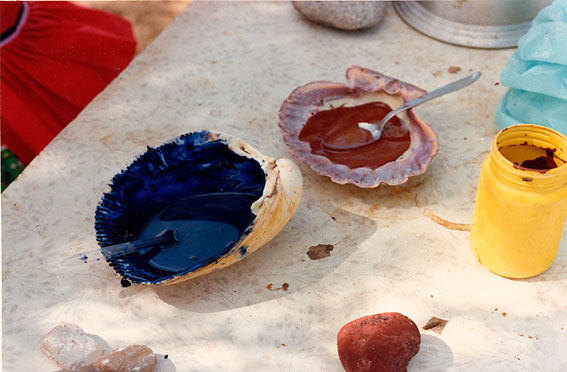
(image from journals.openedition.org)
Getting back to the meaning of the designs, given the 50-year gap between McGee and Xavier's expeditions, it could be the case that McGee's theory about the designs corresponding to clans was correct, and that the Seri had simply adopted different practices between his visit in the late 1800s and Xavier in the 1940s. However, Alfred L. Kroeber, who visited in 1930 and published his findings a year later, also disputes McGee's idea that the designs were representative of clan designations. "My conviction is that the Seri paint primarily for adornment, and that further significance is either secondary or absent…face painting in fact seems to be the chief if not only purely aesthetic expression of Seri culture, their mode of life and psycho-physiological habits being such as almost to prohibit any other form of art. In this painting, on the other hand, they have achieved a high degree of stylizication and taste."12
(image via pinterest)
Additionally, students Dane and Mary Roberts Coolidge further corroborated these findings after their trip in 1939, noting that the girls painted "designs in color out of their own imagination. [They] may get ideas from flowers and seed pods, baskets, birds and snakes, the sun and moon."13 Finally, Xavier confirms both Kroeber's and the Coolidges' accounts. "McGee insisted the designs were totemic clan symbols. So far, I have found no trace of this. The old shaman, Santo Blanco, talked a little of the 'great families' of the past, but did not relate face painting to class symbols at all. He agreed with several other Seri that each family had its own 'class' of paintings, but this may mean no more than favorite family designs, or a feeling of ownership of certain designs." Xavier concludes: "The most definite and interesting classifications made by the Seri were those of the married and unmarried women, men's and children's designs, and those used purely for ornament, in contra-distinction to the protective designs and curing designs…In view of the number explained as protective and curing designs, and the importance apparently attached to them in the minds of the Seri, I must assume them to be of at least equal significance with the painting for adornment."14
(image via the San Diego History Center)
In the 1950s Mexican evangelist missionaries attempted to discourage the Seri from adorning their faces in the traditional manner.15 By the early 1960s commercially produced makeup had arrived to the Seri. Despite the efforts of the missionaries and the Seri's enjoyment of certain modern products, they maintained their customary face painting.16

(image from lugares.inah.gob.mx)
During this decade, anthropologist Mary Beth Moser published a thorough description of how the Seri created the blue pigment they used. She found that it was not the mineral dumortierite, as written by McGee and Kroeber, but a pigment made from root bark, sap and clay. Interestingly, none of these is blue in their natural state. Moser noted that the pigment can only be prepared by older women and the process only observed by girls who have reached menstruation. Men, boys and younger girls are prohibited from observing, as the Seri believe the pigment will not turn blue otherwise.17 (It should be noted that McGee was correct about the red and white pigments, which were harvested from ocher and gypsum, respectively, and mixed with water or grease.18)
As the century wore on, the general flavor of racism towards the Seri turned from hostility and disdain to exotification. Rather than declaring them to be uncivilized cannibals, some descriptions romanticized the face painting practices of the women. This 1958 passage from journalist José Luis Contreras implies that the Seri's cosmetic application enhances their natural features. Normally this wouldn't be a negative observation, but the way he describes them suggests that all Seri have the same facial structure in a way that smacks of fetishization. "Women paint their faces with brightly colored chalk, leaving the flat surfaces of their faces bare and concentrating on the salient cheekbones, in order to make their almond eyes stand out. Red, of course, carefully covers their beautifully molded lips."19 Art historian Deborah Dorotinsky explains the exoticization inherent in Contreras' account: "As with 'Seri Belle', photographed for McGee some 60 years earlier, Seri women and their faces are once again framed by the text in relation to a non-Indian masculine gaze. [Contreras's] photo essay thus communicates that Seri Indians adapt to civilized life, but are exploited and decimated by the evils of civilization. The persistence of facial decoration, appears, then, possibly as a form of resistance to their disappearance as a differentiated ethnicity, even as this exoticization masks their terrible living conditions and serves as an ambivalent way to symbolically distance and attract non-Seri Indians."20
(image via mexico.sil.org)
At this point, the Seri were dealing with even more external forces destroying their way of life. While colonization had started in the 1600s with the Spanish, by the last quarter of the 20th century and continuing into the 21st, the Seri have had to contend with threats such as mining companies, overfishing, drug trafficking and lack of fresh water. However, face painting traditions, along with other aspects of their culture and their land more generally, are being preserved by the Seri themselves as well as artists and nonprofit organizations via art projects, festivals and exhibitions. In 1979 photographer Graciela Iturbide traveled to Sonora and, along with anthropologist Luis Barjau, lived among the Seri for two months. Iturbide published a book of her photos, Those Who Live in the Sand (Los que viven en la arena). Two of the most striking photos feature Seri face paint, one on a Seri woman and the other a self-portrait of Iturbide. According to the National Museum of Women in the Arts blog, "This was a sign of Iturbide’s acceptance into the community, as the Seri women asked to paint her face as they did their own. Iturbide does not exoticize or mimic the practice. Instead, this self-portrait represents her own self-interrogation and integration with her role as a photographer in the indigenous community."
1979 was also the year in which a demonstration hosted by the Sonoran Heritage Program at the Tuscon National Library showed participants how to apply traditional face paint designs using minerals and plants found locally. This was a good way to spread knowledge about the Seri face painting practice, but unfortunately did not seem to have any direct involvement of the Seri.21 In November 1985 a cultural exchange sponsored jointly by the Tuscon Museum of Art and a nearby arts and crafts shop attempted to actually include the Seri people rather than using their designs without their knowledge or consent. The Tuscon Museum brought some Seri community members to showcase and sell their artistry, including woven baskets, carved ironwood, shell necklaces and face painting demonstrations.22 Hopefully they were paid for their services in addition to whatever goods they sold, but it's not clear. That same year the Comcáac Museum opened in Sonora.
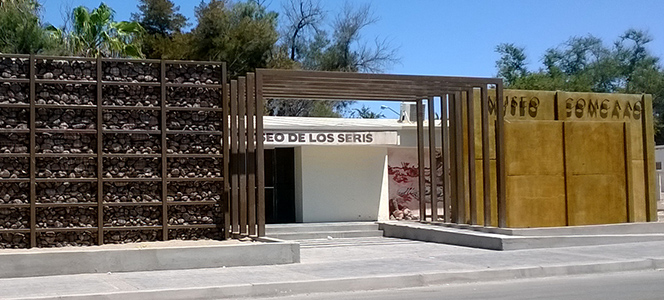 (image from isc.gob.mx)
(image from isc.gob.mx)
Burckhalter's 1996 article on Seri face painting in Native People's Magazine demonstrated that while the practice had diminished slightly, it was still customary among women and girls, who were wearing it almost exclusively for artistic purposes. He spoke with Maria Félix, who stated that "sometimes we paint manta rays or flower designs, but there is no special meaning to my painting…I invented my face decoration because it looks pretty." Burckhalter concludes, "Remembering the ease with which the friendly women settled down on their blanket to the pleasure of painting and of being face painted gave me hope that Seri face painting could again become an everyday sight."23 A year after that, researcher and social worker Alejandrina Espinoza Reyna published a book on the history of Seri face painting after having lived in their community for nearly 10 years. The book contained over 60 designs and two copies – one in Spanish and one in Comcáac – were given to each member. It proved particularly vital for helping preserve the Seri environment, and in 2007 Espinoza was appointed director of the Comcáac Museum. (Much to my frustration, I cannot seem to get a hold of a copy of her book or the subsequent one released by the Instituto Sonorense de Cultura that contains over 250 designs…if anyone can please let me know!)
Similar to the festival held in 1985, in 2009 California-based artist Deborah Small hosted the Seri/Comcáac Women's Artisan Cooperative to participate in events and sell their art at various museums and cultural centers. Interestingly, the same woman who was photographed at the 1985 festival, Angelita Torres, participated in the showcase. I like to think of her as the modern day godmother of Seri face painting who is protecting it and making sure it gets passed down to future generations.
(images from archive.org and deborahsmall.wordpress.com)
More recently, younger Seri people, especially musicians, are actively working to preserve their heritage and environment and showcase their artistry in the process. Morales highlights the Seri band Hamac Caziim, who apply paint for shows, along with musician and activist Zara Monrroy. Monrroy wears the traditional face paint, and not just for performances or speaking engagements. Rather, she also incorporates it into her everyday life just as her ancestors did.
(image from soundcloud.com)
(image from wikipedia.org)
Social media has also played a role in helping maintain the Seri face painting practice. Facebook and YouTube have proved valuable tools in preserving the tradition, particularly during the pandemic. In June 2020, the hashtag #challengehayeenipaii (hayéen ipáii is the Comcáac for "face paint"24) was created to encourage Seri members to don face paint for the annual new year celebration. As large gatherings were prohibited, the challenge allowed virtual participation in the face painting that is customary for Seri new year parties. Additionally, searches for #comcaac and #seris on Instagram yield many examples of face painting.
Naturally, I was wondering what the reaction would be if a non-Seri artist (makeup or otherwise) appropriated the designs without acknowledging their origins, or worse, a makeup brand devised a Seri collection or kit. Because I'm cursed with the ability to envision how a brand will desecrate anything to make a profit, I'm imagining a shell-shaped palette, tiny twig-like brushes and several stencils, even though it looks like the Seri draw their designs freehand. I don't think it would be acceptable even if the collection was directed by a member of the Seri and all proceeds went to their tribe, especially after reading the story of Elizabeth Valdivieso Gurrión, a singer who goes by the name Valgur. Morales concludes her paper by describing the reaction of several Seri members who, upon seeing Gurrion's visage adorned with Seri patterns in 2014, suggested trying to copyright various Seri designs to protect them from outsiders.25 (For the record, it seems Valgur have completely overhauled their brand since the time of Morales's writing, most likely due to the public outcry regarding Gurrión's appropriation of Native cultures that were not her own.)
(image from tuscon.com)
Another example of a prominent non-Seri wearing face paint came in May of this year, when singer Christian Nodal performed at Fiestas del Pitic in his hometown of Sonora. He requested Seri woman Mina Barnett to paint his face before going on stage. Barnett explained the designs were historically worn by warriors for protection in battle, but she also interpreted this modern one as a sign of wishing Nodal well in his future endeavors: "La pintura facial que luce, significa protección para los guerreros. La interpretación que le di al realizarle este diseño fue desearle el bien para todos los proyectos de su vida." An elder Seri member, Alberto Mellado, stated that he had no issue with it and said that Seri designs worn by people not from the community were a gesture of "friendship and goodwill."
(images from enelradar.com)
Nodal apparently liked the concept of Seri face paint so much he got a tattoo of a more traditional Seri design. The backlash was swift and brutal, but not primarily because the public felt it was cultural appropriation: the critique was mostly about facial tattoos in general. Of the dozens of articles covering Nodal's Seri-inspired tattoo, only a handful brought up the issue of cultural appropriation.
According to some coverage, there were accusations of appropriation as Nodal revealed the tattoo on Instagram Stories, but he defended it by claiming he had permission from the Seri to get the design permanently on his face.30 Another article made the argument that while Nodal is not part of the Seri, he grew up in the same region and the tattoo was a way of honoring the people and their locale. I'm still not really sure what to think about those outside the Seri community using the designs even if they explain the culture responsible for them, as both Gurrión and Nodal did. But I don't think I'd feel comfortable getting made up by a Seri person, let alone a tattoo.
In any case, for the Seri, face painting helps connect them to their heritage as well as nature. White means good luck, red signifies the blood of their ancestors, and the blue represents both the desert sky and the ocean that comprise the Seris' surroundings. Most importantly, face painting is integral to forming and maintaining a strong ethnic identity. While the Seri engage in face painting for traditional ceremonies and celebrations, they recognize the importance of wearing face paint for occasions outside of their local community to represent their culture. It becomes not just facial decoration or a way to denote their age/gender, but a means of communicating that they belong to a particular ethnic group. From a purely aesthetic perspective, the delicate and ornate patterns combined with the simple color scheme are incredibly striking and beautiful.
What design is your favorite? Would you like to see more makeup from Indigenous peoples? I'm still not sure whether it's appropriate for me to discuss, but there are so many I'd love to highlight.
1For the purposes of this post, I am using the phrase "face paint" instead of "makeup" as I believe there is a distinction between the two when discussing the practices of Indigenous peoples and/or makeup produced prior to the modern era. Makeup usually refers to the commercially produced items beginning in the early 20th century intended specifically for painting the face for purposes of beautifying; face paint is more the act of applying paint to one's face using pigments that are not made or reserved solely for cosmetic usage and for a variety of purposes besides beautification. Many Indigenous peoples, including the Seri, use the same paint for self-adornment as they do for painting on other surfaces, and sometimes for religious/spiritual purposes in addition to beautification. Articles written in Spanish about the Seri also seem to make this distinction, using "pintura facial" more often than "maquillaje."
2I stumbled across the Seri through Stephen Davies' 2020 book Adornment: What Self-Decoration Tells Us About Who We Are, which I found while browsing the Bloomsbury site. For more general resources on the Seri, see this bibliography and the listings at the University of Arizona Press. For the etymology of Seri and Comcáac, see Stephen A. Marlett, "The Seris and the Comcaac: Sifting fact from fiction about the names and relationships," Work Papers of the Summer Institute of Linguistics, University of North Dakota Session, Vol. 51 , Article 1: 2011. The Arizona Archives Online provides some additional sources.
3W. J. McGee, "The Seri Indians", extract from the Seventeenth Annual Report of the Bureau of American Ethnology (Washington: Government Printing Office, 1898) 162-169. McGee's opinion of the Seri aesthetic was at least somewhat neutral compared to that of retired army captain J. Lee Humfreville, who wrote in the early 1900s that the Seris' use of face paint was intended to "make themselves look as ugly as possible."
4"Low Bids for Hollywood Lovelies Where the Seri Indians Auction Wives," The Times (Shreveport, LA), February 23, 1946, 48.
5"Green Faced Woman of Baja (Lower) California: The Married Women of the Seri Tribe Paint their Faces Green," Ripley's Believe it Or Not, August 31, 1947.
6Gwyneth Harrington Xavier, "Seri Face Painting," Kiva 11, no. 2 (Jan. 1946): 15-20.
7David Burckhalter, "The Traditional Art of Adornment," Native Peoples Magazine 10, no. 1 (Nov-Dec. 1996): 73.
8Ibid.
9Diana Theresa Hernández Morales, "La pintura facial de los comcáac: una creación artística en la dinamica social," (Tesis de maestría, 2016) El Colegio de San Luis, San Luis Potosí, 60-65.
10McGee, "The Seri Indians," 166.
11For more on the Seris' use of shells, see https://shellsonadesertshore.com/
12A.L. Kroeber, "The Seri," Southwest Museum Papers, no. 6 (April 1931): 27.
13"Face Painting Is Art to Seri Indian Girls," Science Newsletter 35, no. 20 (May 20, 1939): 317.
14Xavier, "Seri Face Painting," 19-20.
15William B. Griffen, "Notes On Seri Indian Culture, Sonora, Mexico," (Gainesville: University of Florida Press) 1959, 5.
16Bernice Johnston, "Formerly Fierce Mexican Tribe Nearing Extinction," Arizona Daily Star, June 14, 1964, 9.
17Mary Beck Moser, "Seri Blue," Kiva 30, no. 2 (December 1964): 27-32. By the mid-20th century, Seri were primarily using commercially available blue pigment. For more on the Seris' use of plants, see Richard Stephen Felger and Mary Beck Moser, People of the Desert and Sea: Ethnobotany of the Seri Indians (Tucson: University of Arizona Press), 1985.
18McGee, "The Seri Indians," 165-166.
19José Luis Contreras, "Congcaac, la tribu que agoniza. La raza de los Seri se apaga el infierno de la isla Tiburón," Mañana no. 787 (October 4, 1958), quoted in Deborah Dorotinsky, "It Is Written in Their Faces: Seri Women and Facial Painting in Photography," in Visual Typologies from the Early Modern to the Contemporary: Local Contexts and Global Practices, ed. Tara Zanardi and Lynda Klich (New York: Routledge, 2018) 176.
20Dorotinsky, "It Is Written in Their Faces" 176.
21"Seri Indian Cultural Spirit Relived in Painted Faces," Arizona Daily Star, February 19, 1979, 30.
22Mike Thompson, "Seri Indian Cultural Exchange in Tuscon," Viltis 45, no. 6 (March 1987): 6-8.
23Burckhalter, "The Traditional Art of Adornment," 74.
24Marlett, Stephen A and Mary Beck Moser, Comcaac Quih Yaza Quih Hant Ihiip Hac Cmiique Iitom – Cocsar Iitom – Maricaana Iitom = Diccionario Seri-Español-Ingles Con Indices Español-Seri Ingles-Seri Y Con Gramatica 1ª ed. (Sonora: Plaza y Valdes, 2005) 365.
25Morales, "La Pintura Facial de Los Comcáac," 100-101.




